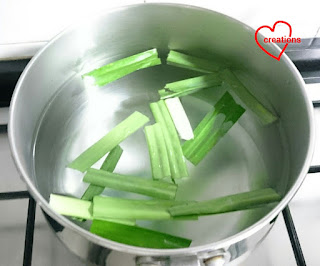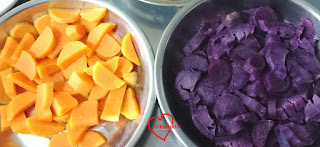Why post this kueh dessert on a blog dominated by chiffon cakes, macarons and cookies? I had the inspiration to make this item for my next culinary arts teaching session (no idea yet when this will happen as suddenly we have more volunteer teachers :p) when my neighbour gave me some freshly made orange sweet potato ondeh-ondeh that were still warm from cooking. The "skin" was so soft and fragrant that I had to give it a try!
I am an adventurous baker and love to explore a variety of bakes but don't have the luxury of time or energy to do a wide range of bakes so I didn't have the chance to learn how to make ondeh-ondeh until now. To my delight, I realised that it is quite simple and very similar to making snowskin mooncakes, which I am familiar with, except that you boil the end product. Of course it is not that simple if your standard of ondeh-ondeh is perfection -- thin tender chewy skin that doesn't burst when cooked but bursts with lots of runny gula melaka when you take a bite.
There are lots of recipes out there for ondeh-ondeh so what I will focus on in this post is how to wrap a substantial amount of gula melaka without driving yourself mad and how to create the cute checkerboard patterns. A very good reference I found and adapted my recipe from is Alan Goh's Travelling Foodies blog. What I found really helpful was his suggested ratio of 3 parts dough to 1 part filling by weight. It really worked for me! Manageable wrapping of the gula melaka but at the same time, awesome experience for the palate. The ratio and weight of each part is just nice, 15g dough and 5 g filling :). I didn't agree with the approximate measurement of gula melaka by volume though. 5g of finely chopped gula melaka works out to be about 1 teaspoonful (measuring spoon, not the kind you use to stir coffee at coffeeshops) that is slightly heaped and lightly packed, and not half teaspoonful as suggested. Great tip about using gently simmering water to cook the ondeh-ondeh too! Prevents the balls from bursting while slowly cooking the ondehs to allow the gula melaka time to melt inside.
Some preparation work to do before we get to the main prep...
In a large pot, boil some water with a few Pandan leaves either knotted up or cut into shorter strips. You will need to use this water for adding to the dough, the dessicated coconut (if you are not using freshly grated coconut) and for boiling the ondeh-ondeh.
Steam some sliced orange and purple sweet potato until soft and mash with a fork or potato masher. I used an unconventional method of pressing the potatoes through a sieve with the back of a metal spoon. This is to ensure that the puree I get is really smooth. Steam the sweet potato slices for about 25-30 minutes.
Freshly steamed sweet potatoes
Prepare some grated coconut by steaming it with pandan leaves and a pinch of salt. Alternatively, you could use desiccated coconut if freshly grated coconut is not available. If you are using desiccated coconut, add some pandan water to it along with a pinch of salt and mix well before steaming. Steam the grated/desiccated coconut for 15 minutes.
I used desiccated coconut as I didn't want to waste any excess freshly grated coconut. Desiccated coconut can be kept for a much longer time and can be used for other bakes (like my pandan kaya gula melaka logcake). Freshly grated coconut would taste better of course.
Recipe for ondeh-ondeh
(Makes about 20 ondeh-ondeh, about 20g each)
110g steamed and mashed orange sweet potato
110g steamed and mashed purple sweet potato
100g glutinous rice flour (divided into 2 equal portions) + extra for dusting
50g Pandan water (you won't need all of it)
100g gula melaka, finely chopped till crumb-like texture
35g grated coconut*
1 Pandan leaf, knotted*
A pinch of salt*
*Alternatively,
35g desiccated coconut
2tbs Pandan water
A pinch of salt
Add about 50g of glutinous rice flour into each of the mashed potatoes.
Use a combination of rubbing in and kneading to work the sweet potato and flour together. Note that different kinds of sweet potatoes have different water content. The orange sweet potato has a higher water content than purple or Japanese sweet potato so what you get after working the flour and mashed orange sweet potato is most likely a moist and soft dough. You most probably don't need to add any water and may have to add some flour instead for the dough to firm up a little if it is too sticky and soft. On the other hand, you may get what resembles fine breadcrumbs for purple sweet potato mix.
Gradually add pandan water, a teaspoon-a tablespoon at a time and knead the dough until it feels firm but pliable, and doesn't crumble or crack easily when you try to shape it. If the dough feels too sticky, add more flour a little at a time. Getting the right texture of dough is important. Too wet and sticky and it becomes difficult to work with, prone to breaking when wrapping the filling and the end product has a sticky bite. Too dry and the dough cracks or crumbles easily when you try to wrap the gula melaka.
Purple sweet potato dough
You may store any unused dough by wrapping in clingwrap and refrigerating it up to a few days.
Portion the dough into 15g balls if you are making single-coloured ondeh-ondehs. Portion the dough into 8g balls for checkerboard ondeh-ondeh.
Here is how you wrap the filling without going crazy. Create a "bowl" using your fingers that is deep enough to match approximately the scoop height and width of your teaspoon (measuring spoon please). If you find the dough cracking up or is too sticky to work with at this point, feel free to dab on a bit of pandan water or dust with a bit of flour.
Fill the teaspoon with a small heap (not too "mountainous" please) of gula melaka and gently but firmly use a finger to press it into the spoon to pack it in a little. This will help the gula melaka stay in a ball shape as you wrap, which will make life a lot easier. I can't imagine trying to wrap loose "sand" :P.
Tip the gula melaka into the "bowl" of dough.
Carefully gather in the dough over the ball of gula melaka.
Pinch the dough together at the opening of the hole. Make sure you seal it completely to prevent the gula melaka from leaking out.
Dough ball with wrapped filling
If you are making checkerboard ondeh-ondehs, take an 8g portion of dough, place it on baking paper that has been folded into half such that there is a noticeable crease. Fold the baking paper over the ball of dough with the dough nestled against the fold. Use your palm to flatten the dough such that a rough semicircle shape is formed. Lightly dust the baking paper with flour if necessary, i.e. the dough sticks to the paper.
Repeat the above step for the other coloured dough. Place the two semi-circles next to each other, overlapping a little. Fold the baking paper over and use your palm or fingers to press along the seam.
Use a bench scraper or knife to cut the dough into half (left picture below). Flip one piece over such that the reverse order of colours are showing (right picture below).
Overlap the two pieces and fold the baking paper over it. Press the seams together.
Tadah! Checkerboard dough!
Wrap the filling as shown above with the single-coloured dough. Just pinch any seam together that seems to be splitting as you wrap the filling. Do master the single-coloured dough wrapping before you attempt this.
Checkerboard dough ball with wrapped filling
Assembled ondeh-ondehs
Gently drop the balls into a gently simmering pot of pandan water (I removed the leaves) and swirl the water a little to prevent the balls from sticking to the bottom of the pot. When the balls start to float, remove them using a wired sieve or one of those ladles with holes that you use for steamboat.
Place the cooked balls on the plate of grated coconut and roll them to coat with coconut.
Serve immediately if possible!
A close-up view of the runny gula melaka inside!
I did a trial earlier on with Japanese sweet potato as well and coloured the dough green with homemade pandan juice. I was more generous with the filling so a few of the ondehs burst but checkout the awesome runnyness and thin "skin"!
Yums!
With love,
Phay Shing

























Gorgeous!
ReplyDeleteThank you Mark & Belle :)
Delete